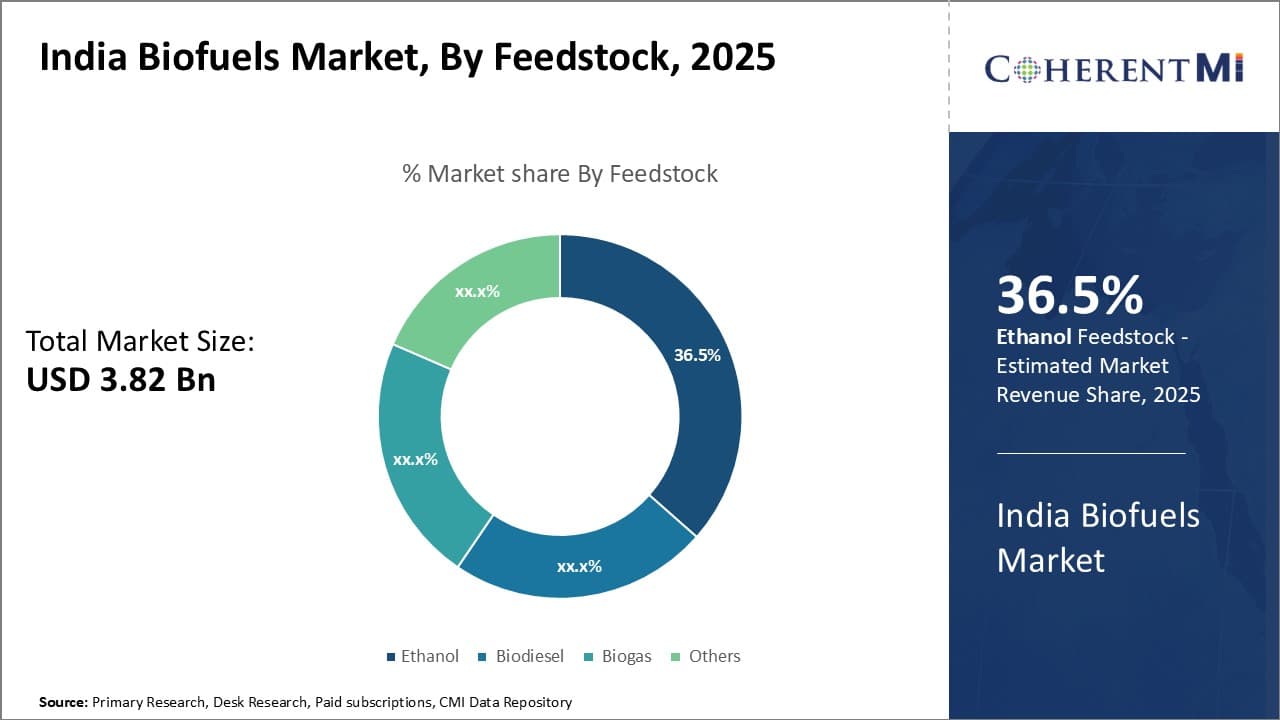

India biofuels market size was valued at US$ 3.82 Bn in 2025 and is expected to reach US$ 15.56 Bn by 2032, growing at a compound annual growth rate (CAGR) of 22.2% from 2025 to 2032. Biofuels are fuels produced directly or indirectly from organic material (biomass) including plant materials and animal waste. The primary biofuels are ethanol and biodiesel which are used as transportation fuel. Biofuels in India are used to supplement traditional fossil fuels and help address energy security and environmental challenges. The key growth drivers for India biofuels market include government support and policies, rising energy demand, environmental benefits, and rural development.
India biofuels market is segmented by feedstock, application, and technology. By feedstock, the market is segmented into ethanol, biodiesel, biogas, and others. Ethanol is expected to dominate the market over the coming years. Ethanol is predominantly used in India for blending with petrol
India Biofuels Market Drivers:
India Biofuels Market Opportunities:
India Biofuels Market Restraints:
Analyst Viewpoint:
India biofuels market has significant growth potential over the next decade. The government's focus on promoting ethanol blending with gasoline presents a major driver for the market. According to Economic Research Service. The recent increase in the ethanol blending mandate from 5% to 20% by 2032 will substantially increase ethanol demand. Several states like Uttar Pradesh and Karnataka are expected to dominate ethanol production due to abundant sugarcane availability.
However, low availability of feedstock and competing demand from the sugar industry may pose challenges. Erratic monsoons and limited irrigation facilities affect the availability of sugarcane and other feedstocks. There is also a risk of higher food prices if feedstock is diverted from the food chain to fuels. Setting up large distillation units and supply infrastructure will require major capital investments.
Nevertheless, the initiative to exploit non-food biomass sources like agricultural residues and sugarcane pulp presents new opportunities. This can help alleviate feedstock shortage issues. The market is also poised to expand beyond ethanol. Biodiesel demand is expected to grow driven by the use of waste cooking oil as a feedstock. Advances in research on second-generation technologies will further broaden the feedstock base.
In conclusion, while the biofuels industry faces challenges, significant growth looks set over the long run given the country's push for clean energy and environmental goals.
Market Size in USD Bn
CAGR22.2%
| Study Period | 2025-2032 |
| Base Year of Estimation | 2024 |
| CAGR | 22.2% |
| Market Concentration | High |
| Major Players | Reliance Industries, Indian Oil Corporation, Bharat Petroleum, Hindustan Petroleum, Tata Chemicals and Among Others |
 To learn more about this report, Download Free Sample Copy
To learn more about this report, Download Free Sample CopyThe competitive landscape of the biofuels market in India is dynamic and evolving, driven by a combination of government policies, technological advancements, and market dynamics.
New product launches:
Acquisition and partnerships:
Would you like to explore the option of buying individual sections of this report?
Yash Doshi is a Senior Management Consultant. He has 12+ years of experience in conducting research and handling consulting projects across verticals in APAC, EMEA, and the Americas.
He brings strong acumen in helping chemical companies navigate complex challenges and identify growth opportunities. He has deep expertise across the chemicals value chain, including commodity, specialty and fine chemicals, plastics and polymers, and petrochemicals. Yash is a sought-after speaker at industry conferences and contributes to various publications on topics related commodity, specialty and fine chemicals, plastics and polymers, and petrochemicals.
India Biofuels Market is Segmented By Feedstock (Ethanol, Biodiesel, Biogas, Others) By Application ...
India Biofuels Market
How big is the India Biofuels Market?
The India Biofuels Market is estimated to be valued at USD 3.8 in 2025 and is expected to reach USD 15.5 Billion by 2032.
What are the major factors driving the India biofuels market growth?
Government support policies, rising energy demand, environmental benefits, and rural development are major factors driving India biofuels market growth.
Which is the leading application segment in India biofuels market?
Fuel is the leading segment in India biofuels market primarily used for petrol blending.
Which are the major players operating in India biofuels market?
Reliance Industries, Indian Oil, Bharat Petroleum, Hindustan Petroleum, and Tata Chemicals are major players in India biofuels market.
What will be the CAGR of India biofuels market?
The CAGR of India biofuels market is estimated to be around 22.2% from 2025-2032.